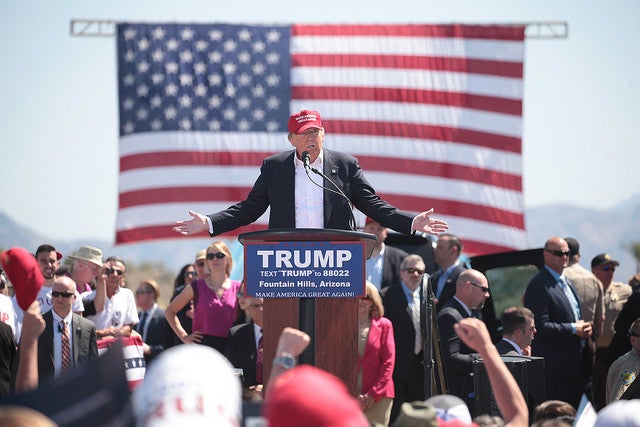
Donald Trump addresses supporters at a Fountain Hills, Arizona, rally.
Three debates, one tape bragging about sexual assault, an alleged rape lawsuit, and far too many inflammatory and offensive statements later, many Americans have wondered how we got here—or, more to the point, how Donald Trump got here.
Uncomfortably close to our country’s 58th presidential election, the mainstream news media began to call out Trump’s incitement, disregard for facts, as well as his sexist and racist behavior and language. That was a noticeable shift from glaringly context-free headlines from a month ago, like “Trump: Obama was born in US.”
Of course, this change prompted Trump and his surrogates to accuse the news media of being “rigged.” With increasing frequency, he has portrayed the news media as shamefully biased.
Trump is right, but not in the way he thinks he is. He has received about three times as much coverage as Hillary Clinton, though much of it has been negative. But more significant is the abundance of what media researcher Maxwell T. Boykoff describes as “informational bias.” We, the news media and the public, have become addicted to false balance.
This journalistic practice emerged out of relentless economic pressures brought on by the 24-hour news cycle, online disruption of legacy media, the increasing corporatization of news media and the public’s insatiable hunger for clickbait.
In the 1990s, the emergence of the 24-hour news cycle and its high-conflict “Crossfire”-style duels favored weighting competing views equally regardless of contextual factors such as accuracy, or majority vs. minority opinions.
Boykoff applied false balance to news coverage of climate change, and other scholars have invoked it when indicting journalistic missteps in reporting the link between vaccines and autism. In both cases, a fringe opinion with incomplete or inaccurate facts was able to hijack the position of equal counter-arguer.
In a recent case study, I applied concepts of false balance to network news coverage of the 2011 “birther” controversy. Those who wonder how Trump got this far only need to view the television-news footage I did. It plays out like a tutorial on how to deploy the news media as one’s personal reality show. Trump was his own best student.
Back in 2011, most treated his unofficial candidacy for president and his claims that Barack Obama was born in Kenya as jokes, extensions of “The Apprentice.”
Yet this so-called controversy yielded more than 30 discrete segments on the five major television news networks in April 2011.
CNN alone aired 14 of those pieces—an average of nearly one every other day—including a four-part “exclusive investigation” by Anderson Cooper and “a team of reporters in Hawaii.” They left no stone unturned, interviewing everyone from officials in charge of state records to a woman whose son was born on the same day as Obama and recalled seeing a “black baby” in the hospital nursery. The series also featured an unedited “exclusive” interview with Trump, aired over multiple days.
Throughout the coverage, Cooper, and journalists from all the networks, repeatedly described the “birther” claims as “outrageous,” “widely discredited,” “outlandish.” On more than one occasion, Cooper likened the belief to asserting “the moon is made of cheese.”
So why an in-depth investigation on such outlandishness? Why did networks uniformly give Trump far more airtime than Obama, his advocates and common sense?
Trump played the news media expertly, offering “exclusive” interviews so frequently the word lost its meaning. He staged press conferences in which he appeared increasingly presidential, emerging from his private jet on a tarmac to take credit for compelling Obama to release his “long-form” birth certificate.
The news media-sponsored reality show abruptly came to an end the night of May 1. Why? Because hours after confidently roasting Trump at the White House Correspondents Dinner, Obama announced that he had authorized a raid on a compound in Pakistan, and that Osama bin Laden, the architect of 9/11, was dead.
Trump disappeared from the news media after that, as did the birther “debate”—until it resurfaced during the current campaign. By May 16, 2011, Trump announced he was not running for president. But he had learned. The next time, he would have to return armed with the equivalent of multiple birther controversies, lobbing out one after the other for the news media to chase.
In the current election, Politifact and other media outlets’ fact-checking sites attempt to provide much-needed context, but media shareholders, audiences and, most of all, Trump know all too well that, given the choice of reading an annotated debate transcript versus a lowest-common-denominator headline about Miss Universe’s weight, performance-enhancing drugs, “bad hombres” or grabbing p***y, there is no contest.
American journalism history prizes tales of the past in which reporters recognized that there were not two equal sides to a story. I teach general-education media history courses at American University that hold these moments up as shining examples: Edward R. Murrow’s takedown of Sen. Joseph McCarthy, newspaper and television reporters’ brave documenting of brutal crackdowns on anti-segregation protesters, and Walter Cronkite’s stepping out from behind the anchor’s desk during the Vietnam War.
What will journalism history books say about the 2016 presidential election? I hope for the best-case scenario at this point, which is that the news media learned an important lesson from candidate (not President) Trump and began to move away from high-conflict, low-cost models of coverage.
